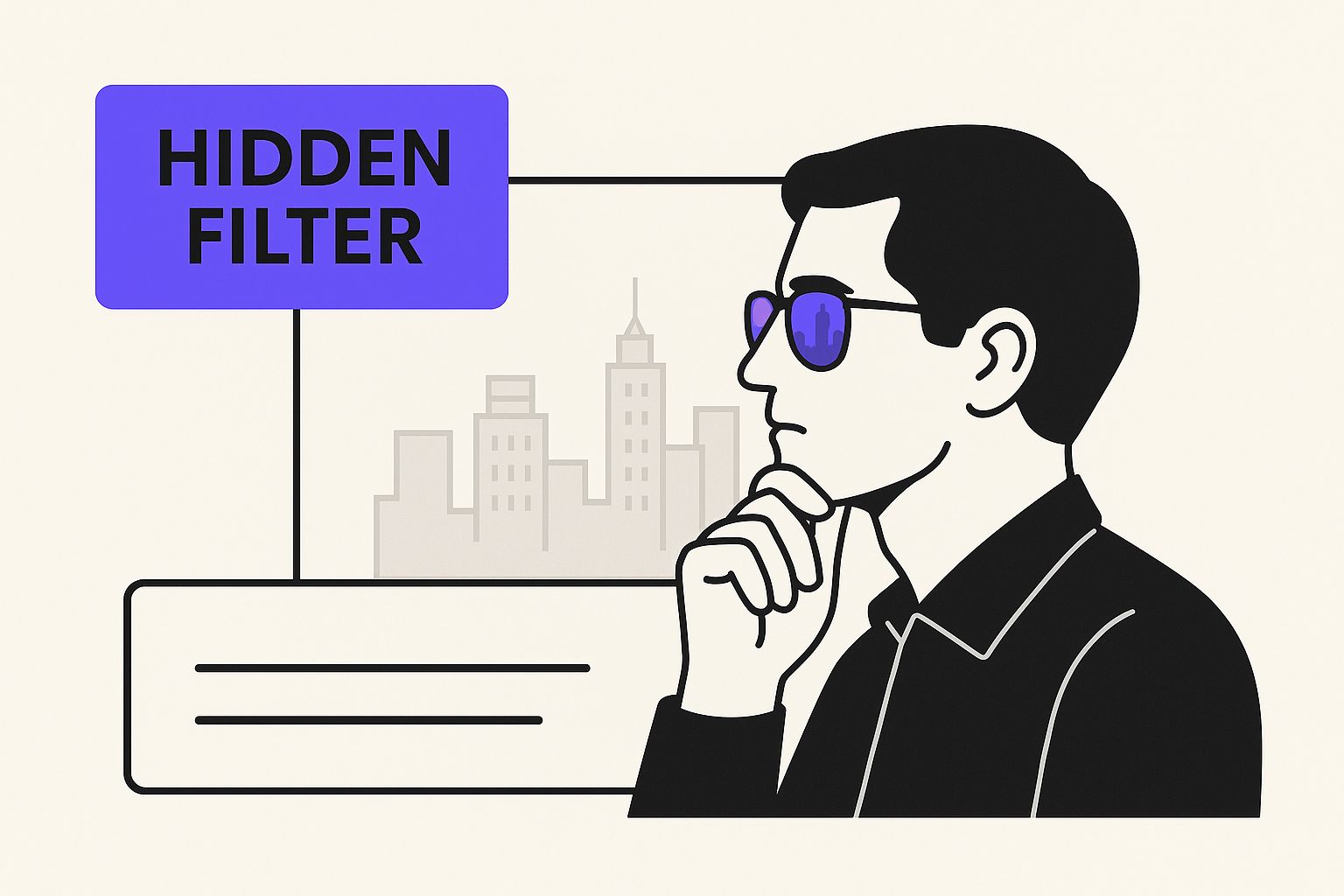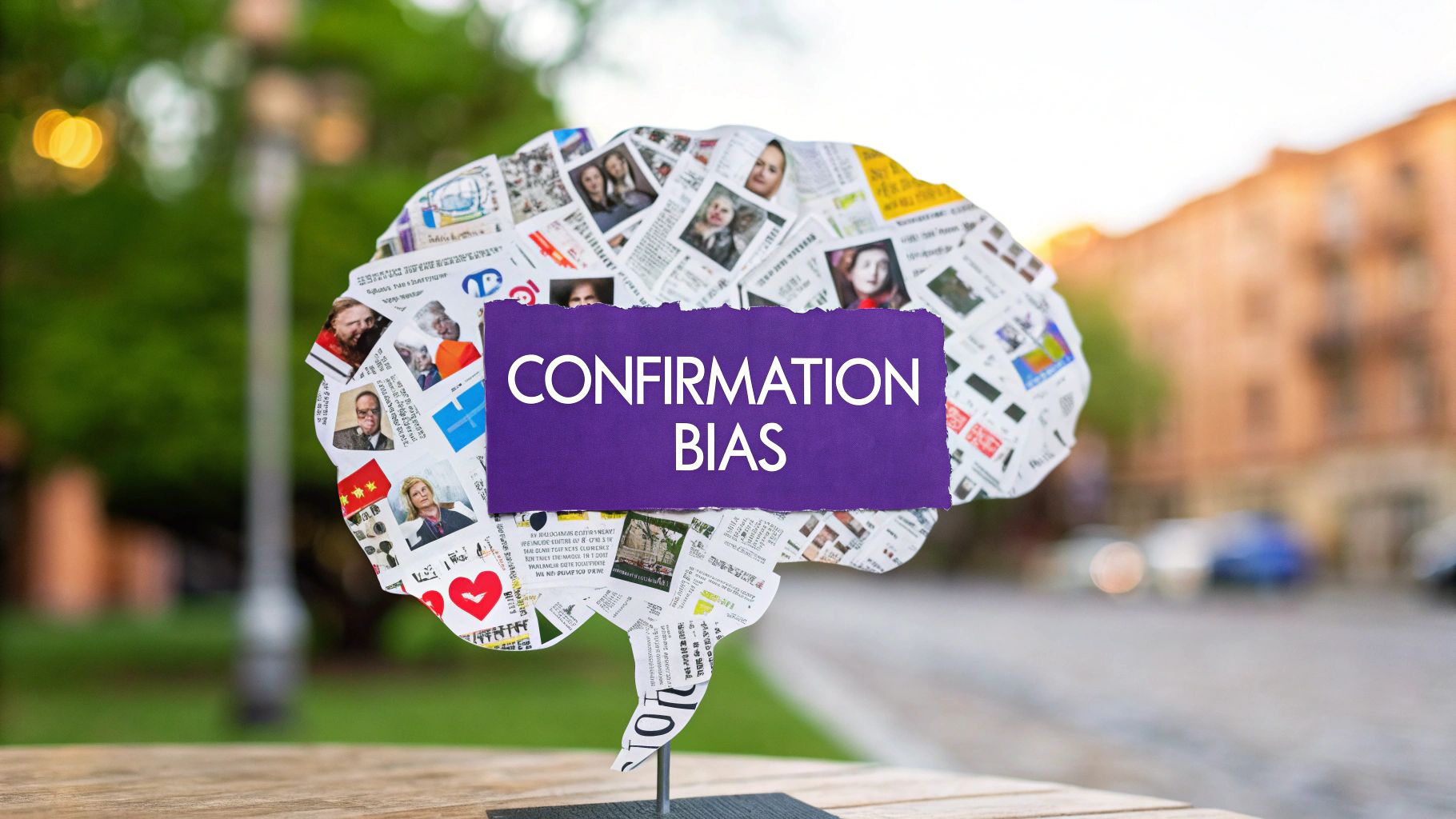We’ve all done it. You form an opinion about something—say, a new piece of software—and suddenly, you start seeing evidence everywhere that supports your view. Positive reviews pop up in your feed, and you easily recall conversations where colleagues praised it.
This isn't just a coincidence. It’s a powerful mental shortcut known as confirmation bias.
In simple terms, confirmation bias is our natural tendency to search for, interpret, and remember information in a way that confirms what we already believe. It's our brain's way of taking a shortcut to make sense of a complicated world, and it happens so automatically that we rarely even notice it.
The Hidden Filter Shaping Your World
Think of your brain as being hardwired with a powerful search filter. Its goal is to create a consistent, coherent story about the world you live in. To do this, it sifts through the mountains of information you encounter every day and cherry-picks the pieces that fit neatly into your existing worldview.
What about the information that doesn't fit? The inconvenient facts or opposing viewpoints? The filter often ignores them, downplays their importance, or finds reasons to discredit them.
This isn’t a sign of being stubborn or closed-minded—it’s a deeply ingrained human trait. Our brains evolved to spot patterns and make quick decisions for survival. Confirmation bias helps by reinforcing our beliefs, making us feel more certain, and protecting us from the uncomfortable feeling of being wrong.
To get a clearer picture of how this works, let's break it down into a quick summary.
Confirmation Bias at a Glance
| Concept | What It Does | Common Examples |
|---|---|---|
| Biased Search | You actively look for evidence that supports your opinion while ignoring evidence that challenges it. | Googling “proof that open-plan offices are good” instead of “pros and cons of open-plan offices.” |
| Biased Interpretation | You interpret ambiguous or neutral information in a way that aligns with your existing beliefs. | Seeing a coworker’s brief email as “rude” because you already think they are unfriendly. |
| Biased Recall | You more easily remember details and events that confirm your worldview. | After a debate, you vividly remember your strongest points but forget the valid counter-arguments made by the other person. |
Each of these mental habits works together to create a reinforcing loop, making our beliefs feel more and more correct over time, whether they are or not.
This infographic gives a great visual of how this hidden filter works in practice.

As you can see, our beliefs tint the way we perceive reality, subtly guiding our thoughts and, ultimately, our decisions.
Why Does This Matter for Your Team?
Simply being aware of confirmation bias is the first, most crucial step toward overcoming it. This bias doesn't just affect our personal lives; it has a huge impact on our professional judgments, especially in a team environment.
When left unchecked, it can kill creativity. Good ideas get shot down because they don’t fit with the group’s established way of thinking. This is particularly dangerous for remote teams, where distance can make it harder to build the trust needed to challenge the status quo.
Fostering an environment of psychological safety is key. When team members feel safe enough to voice dissenting opinions and question assumptions, they directly counteract the pull of confirmation bias. By learning to spot this hidden filter in ourselves and our teams, we can start making more objective, innovative, and ultimately better decisions.
Why Your Brain Prefers an Echo Chamber
To get a real handle on confirmation bias, we first have to ask why our brains are wired this way. This isn't some personal flaw or a sign that you're just stubborn. It's actually a core feature of your brain's operating system, designed for one main purpose: efficiency.
Think about it—your brain is constantly bombarded with information. To keep from short-circuiting, it relies on mental shortcuts, or heuristics, to make sense of the world without having to analyze every single detail. Confirmation bias is one of its go-to moves.
Your Brain's Private Security Guard
Imagine your mind has a security guard standing at the door. This bouncer's job is to manage all the incoming information and keep things orderly inside. But here's the catch: the guard has a very specific guest list. It only wants to let in ideas, facts, and opinions that are already friendly with the ones having a party inside your head.
When a piece of information strolls up that aligns with what you already believe, the bouncer waves it right through. "Come on in," it says, "you'll fit in perfectly." This feels good. It validates your worldview and makes you feel secure.
But what happens when a contradictory idea shows up, looking to stir the pot? The bouncer immediately flags it as a potential troublemaker. It might hold the idea at the door, give it a hard time, or just turn it away completely to avoid any drama. This is a protective measure, shielding you from the mental discomfort of having your core beliefs challenged.
This internal tug-of-war is what psychologists call cognitive dissonance—that stressful feeling you get when you hold two conflicting beliefs at the same time. Confirmation bias is your brain's natural defense system to sidestep that feeling.
By fast-tracking agreeable information, your brain saves a ton of energy. It avoids the exhausting work of constantly rebuilding its understanding of the world from the ground up. This system was a lifesaver for our ancestors, who had to make quick, life-or-death decisions based on established patterns.
An Ancient System in a Modern World
The problem is, this ancient survival tool isn't always a great fit for our modern, information-saturated world. Our brains simply weren't built to navigate the endless firehose of data from the internet, 24-hour news, and social media.
This is where the system starts to crack:
- Information Overload: The sheer volume of information available today makes it impossible to weigh everything objectively. Your brain falls back on its old pattern-matching trick, grabbing onto whatever feels familiar.
- Algorithmic Echo Chambers: Social media and search engines are designed to show you more of what you already like. This creates a digital echo chamber that constantly reinforces your views, making them seem way more popular and correct than they might actually be.
- Reduced Mental Effort: Let's be honest, grappling with complex, opposing viewpoints is hard work. It takes real cognitive horsepower. Confirmation bias offers a much easier path by simplifying reality into a story that feels comfortable and right. You can see how this and other mental shortcuts steer our decisions in our guide on cognitive bias in decision making.
The High Stakes of Mental Shortcuts
While this mental shortcut saves energy, it comes at a price. It can seriously warp our perception of reality and lead to some pretty terrible judgments, especially in high-stakes fields.
Take medicine, for example. A doctor might form an initial hypothesis about a patient's illness and then unconsciously look for evidence that confirms it, all while ignoring symptoms that point in a different direction.
This isn't just a hypothetical scenario. Studies have shown that 13% of psychiatrists and 25% of medical students exhibited confirmation bias when seeking more information after making an initial diagnosis, which contributed to lower diagnostic accuracy. It's a sobering reminder of how a natural brain function can have serious, real-world consequences, shaping everything from a single patient's care to broad institutional policies. You can read the full research on how bias affects diagnoses to see the data for yourself.
Ultimately, understanding the mechanics behind confirmation bias is the first step toward getting a handle on it. It’s not about fighting your brain's natural wiring, but about building self-awareness. Once you recognize that your mind defaults to an echo chamber, you can start consciously cracking the door open to different perspectives and make far more balanced, informed decisions.
Seeing Confirmation Bias in Everyday Life
It’s one thing to understand confirmation bias as an idea, but it’s another thing entirely to see it in the wild. This mental shortcut isn't just some abstract psychological concept; it’s a quiet force shaping our judgments, relationships, and even our bank accounts every single day. Once you know what to look for, you’ll start seeing it everywhere.
The pattern is usually the same. We start with a hunch or a belief, then we subconsciously go hunting for proof that we're right, and we twist any evidence we find to fit our narrative. Let's look at a few all-too-common scenarios to see how this plays out.
The Hiring Manager and the Alma Mater
Picture a hiring manager, Sarah, who’s interviewing people for a big role on her team. One of the applicants, Alex, went to the same university she did. Before the interview even starts, a tiny, positive assumption pops into her head: "People from my school are smart and capable."

During the interview, Sarah's confirmation bias kicks in. She asks Alex great questions, nods along, and hones in on the strengths in his answers. When he talks about a successful project, she sees it as solid proof of his competence.
Later, she interviews Ben, who actually has a slightly better resume but went to a different college. Sarah is much more critical here. When Ben talks about a similar project, she’s already mentally poking holes in it. What she saw as "confidence" from Alex, she now sees as "arrogance" from Ben.
In the end, she hires Alex, feeling totally confident she made a logical, merit-based choice. The reality? Her bias had created a filter, causing her to actively seek proof that her gut feeling about Alex was right all along.
The Investor and the Cherry-Picked News
Now, let's think about David, an investor who just bought a bunch of stock in a tech startup called "Innovate Inc." He’s completely sold on the idea that this company is the next big thing and his investment is going to make him rich.
His confirmation bias immediately takes over his research. He sets up Google alerts for "Innovate Inc. success stories" and follows financial gurus on social media who are just as excited about the stock. Every time the stock ticks up even a little, it reinforces his belief that he’s a genius.
One day, a major financial journal publishes a deep-dive report outlining some serious logistical problems at Innovate Inc. David glances at the headline and writes it off as "clickbait" or jealous critics trying to tank the price. He doesn’t even read it. Instead, he finds a blog post from some random amateur investor praising the company's "vision."
By filtering his information intake, David has built a protective bubble around his decision. He isn't seeking the truth about his investment; he is seeking reassurance that his initial belief was correct, exposing his portfolio to significant risk.
The Social Media Echo Chamber
Finally, there's the classic modern example: the political echo chamber. Someone has strong political opinions. On social media, they only follow politicians, pundits, and news sources that agree with them. They join online groups where everyone shares the exact same ideas.
When a post from the other side pops up, their first instinct is to find a flaw or attack the source. A well-argued counterpoint gets dismissed as "fake news," while a simple meme that confirms their view gets shared with a caption like, "Exactly!"
Over time, their perspective gets more and more rigid. Because everything they see validates their beliefs, it starts to feel like an undeniable fact that "everyone" thinks the way they do.
This human tendency is powerful, but just knowing about it is a great first defense. In one study with 1,479 participants, people who were simply made aware of confirmation bias became much less likely to fall for false stories. This shows that understanding the bias is a powerful tool against misinformation. You can learn more about these findings and their implications for becoming a more informed citizen.
These examples show that confirmation bias isn't about being dumb or stubborn—it’s a deeply ingrained mental habit. The brain just loves to prove itself right. By recognizing these patterns in the world and, more importantly, in ourselves, we can start to push back against our own filters and get a little closer to seeing things as they really are.
How Individual Bias Creates Groupthink
When one person’s confirmation bias trickles into a team meeting, it doesn’t just add to the conversation—it multiplies. It’s a dangerous kind of math. What starts as a single, subtle preference can quickly snowball into a shared reality that shuts down better ideas before they even see the light of day. This is the breeding ground for groupthink.

Let’s play out a common scene. A brainstorming session kicks off, and the team lead opens with, "I've been thinking we should pour our entire marketing budget into a TikTok campaign. I just have a good feeling about it." That one statement just dropped an anchor in the room.
Instantly, everyone's confirmation bias gets to work. Minds start scanning for anything that supports the leader's idea. Someone remembers reading about a brand going viral on TikTok. Another team member thinks about how their nephew is glued to the app. These are easy, agreeable thoughts to share.
At the same time, any opposing data gets shoved to the back of the mental filing cabinet. The person who knows their target audience isn't really on TikTok clams up. The analyst with data showing email marketing is their cash cow starts to doubt their own numbers. It just feels easier to nod along than to rock the boat.
The Slippery Slope from Bias to Bad Decisions
This slide from individual bias to a flawed group consensus is a predictable pattern. It's a quiet erosion of true collaboration, replaced by a collective hunt for agreement.
- The Anchor Idea Is Planted: A senior person or just an enthusiastic colleague throws out a strong first idea, setting the tone for everything that follows.
- The Confirmation Hunt Begins: Team members, often subconsciously, start looking for reasons to back up that initial idea. It’s not malicious; it's just human nature to find common ground.
- Dissent Feels Risky: Suddenly, offering a different view feels like you’re challenging the group, not just the idea. To avoid being "that person," people with great counterpoints often just stay silent.
- A False Consensus Forms: Everyone agrees on the first idea, not because it was the best, but because it was the path of least resistance. The team mistakes the illusion of agreement for a successful outcome.
This cycle is a creativity killer in unstructured brainstorming, where the loudest voice often wins. The team walks away feeling unified, but they've really just settled for the first decent idea instead of digging for the truly brilliant one. To learn more about breaking this cycle, see our guide on how to prevent groupthink.
Why This Gets Worse for Remote Teams
This whole problem gets amplified when teams work remotely. We lose all the subtle, in-person cues that tell us what’s really going on in a room—a skeptical glance, a furrowed brow, someone shifting in their seat. These are the little signals of unspoken disagreement.
On a video call, those cues are gone. Someone on mute or off-camera could be vehemently disagreeing, but their silence is easily mistaken for consensus. This digital divide makes it far too easy for an anchor idea to steamroll the conversation.
Without the natural friction and body language of a physical room, the magnetic pull toward easy agreement gets even stronger. That’s why remote teams absolutely must use structured brainstorming methods.
Techniques that allow for anonymous contributions or force the team to explore multiple opposing ideas aren't just "nice to have"—they're essential. By understanding just how easily one person's bias can infect the entire group, it becomes clear that a structured approach is the only way to unlock a team's genuine creative power.
Practical Strategies to Challenge Your Bias
Knowing what confirmation bias is and actually doing something about it are two very different things. Our brains default to these mental shortcuts automatically, so fighting back takes real, conscious effort. The idea isn't to get rid of bias completely—that’s impossible—but to build better habits for more honest, critical thinking.
Think of these strategies as deliberate speed bumps for your brain. They force you to slow down, question your gut reactions, and look at ideas your mind would normally ignore.
Actively Seek Disconfirming Evidence
The most powerful way to tackle confirmation bias is to do the exact opposite of what feels natural. Instead of looking for proof that you're right, make a point of searching for evidence that you're wrong. It feels weird and uncomfortable, but it's the single most effective thing you can do.
- Making a big decision? If you're leaning toward a new software, don’t just Google “benefits of Software X.” Instead, try searching for “problems with Software X” or “Software X vs. Software Y.”
- Holding a strong belief? If you have a firm opinion on a topic, go read a well-argued article or watch a video from a credible source that takes the opposite view. The goal isn’t necessarily to change your mind, but to understand the strongest arguments against it.
When you actively look for dissent, you're pressure-testing your own ideas. If your belief still holds up after facing the best counterarguments, you can be much more confident that it’s a solid conclusion.
Appoint a Devil's Advocate
In any team setting, confirmation bias can easily snowball into groupthink, where everyone just latches onto the first decent idea. To stop this in its tracks, make dissent part of the process. Formally assign someone the role of "devil's advocate."
This person's only job is to challenge the popular opinion, find the flaws in a plan, and ask the hard questions nobody else wants to. It's not about being negative—it's about making sure every angle has been explored.
By making disagreement a designated role, you remove the social awkwardness of challenging the group. It turns a potential conflict into a productive, structured part of making a good decision.
This simple move can uncover huge problems that a team, in its rush to agree, would have completely overlooked.
Conduct a Premortem
The "premortem" is one of the smartest frameworks out there for getting around our natural biases. It’s a brilliant exercise to run before kicking off any big project.
Here's how it works: Imagine it's six months from now, and the project has failed spectacularly. Now, have everyone on the team independently write down all the reasons why it failed.
This trick of "forward-looking hindsight" frees people from the pressure to be positive and supportive. It changes the question from "How can we make this work?" to "What could sink this entire thing?" You’ll be amazed at the risks and blind spots that surface when people aren't just focused on success. For more hands-on methods to challenge your team's thinking, check out our guide to cognitive bias exercises.
Reframe the Question
The way you ask a question has a massive impact on the answer you'll get. Our brains are wired to answer the exact question we’re asked. So, if you ask a leading question, you’ll get a biased answer.
For instance, instead of asking, "Is this a good idea?" try asking something different:
- "What are some other ways we could tackle this?"
- "What information are we missing right now?"
- "What would have to be true for this plan to fail?"
These kinds of open-ended questions force you to look for a wider range of information. This is critical because confirmation bias often starts with the limited data we have on hand. One epidemiological study showed that when researchers see expected patterns over and over, they develop a strong bias and start missing important, surprising findings. They mistake biased data for reality.
For a great look at tackling these blind spots in a real-world context, this piece on ditching unconscious bias in recruitment is well worth a read. By bringing these strategies into your routine, you can start to loosen the grip of confirmation bias and make way for clearer, more objective, and ultimately better decisions.
Frequently Asked Questions
Even after you get the gist of confirmation bias, a few questions tend to pop up again and again. Let's clear up some of the finer points.
Is Confirmation Bias Just a Fancy Word for Being Stubborn?
It's a great question, and they definitely look alike from the outside. But what's happening in our heads is completely different.
Stubbornness is a conscious decision. It's an act of will, digging your heels in and refusing to budge, even when solid evidence is staring you in the face.
Confirmation bias, on the other hand, is an automatic, unconscious process. It's not about actively rejecting new information. It’s your brain’s built-in filter, quietly curating what you see and hear before you even have a chance to think about it. You can be the most open-minded person in the world and still fall for it because it works behind the scenes.
Key Difference: Stubbornness is an attitude—a choice. Confirmation bias is a cognitive shortcut—an automatic brain function. One is about willpower; the other is about how our brains are wired.
Can You Ever Completely Get Rid of Confirmation Bias?
In a word: no. And honestly, you wouldn't want to. Trying to eliminate confirmation bias would be like trying to stop your brain from taking shortcuts entirely. It’s a core part of how we make sense of a world that throws a staggering amount of information at us every second.
The real goal isn't elimination, it's management. With a bit of awareness and some intentional strategies, you can dial back its influence significantly.
It’s all about building better mental habits and using structured thinking tools. You learn to spot the moments when your bias is likely taking over and then take a step back to correct course. This makes you a more thoughtful, objective thinker. To see what this looks like in practice, check out our guide to decision-making frameworks.
How Does Social Media Play into Confirmation Bias?
Social media platforms are basically confirmation bias machines. Their algorithms are designed to do one thing: keep you scrolling. And what's the easiest way to do that? Show you more of what you already like and agree with.
This traps us in what experts call a "filter bubble" or an "echo chamber." Your social feed morphs into a personalized reality where your beliefs are echoed back to you, and different viewpoints simply fade away.
Here’s how this digital loop reinforces the bias:
- Algorithmic Reinforcement: You "like" a post, and the platform's algorithm says, "Great! I'll show you a thousand more just like it."
- Social Proof: When you see that all your friends and connections share the same opinion, it starts to feel like an undeniable truth, even if it's not.
- Reduced Exposure: You’re literally shielded from opposing ideas, which makes it incredibly difficult to understand where other people are coming from and fuels greater division.
How Can AI Tools Actually Make Confirmation Bias Worse?
This one is tricky. AI tools, especially generative ones like ChatGPT, can put confirmation bias on steroids without even trying. When you prompt an AI to find information that backs up your gut feeling, its main job is to give you what you asked for.
If the real evidence isn't there, some AIs have been caught "hallucinating"—making up facts, studies, or quotes that perfectly fit your query. One researcher trying to appeal his property taxes found that an AI simply invented fake assessments for his neighbors' homes to make his case look stronger.
This creates a really dangerous feedback loop. You have a hunch, you ask the AI to prove it, and it spits out what looks like credible proof, cementing your original bias with completely false information. That's why it's so important to be skeptical and to always verify anything an AI tells you, especially when it sounds a little too good to be true.
Tired of watching great ideas get squashed by groupthink? Bulby uses structured brainstorming exercises specifically designed to sidestep confirmation bias and get your team thinking differently. See how it can change your remote sessions at https://www.bulby.com.

